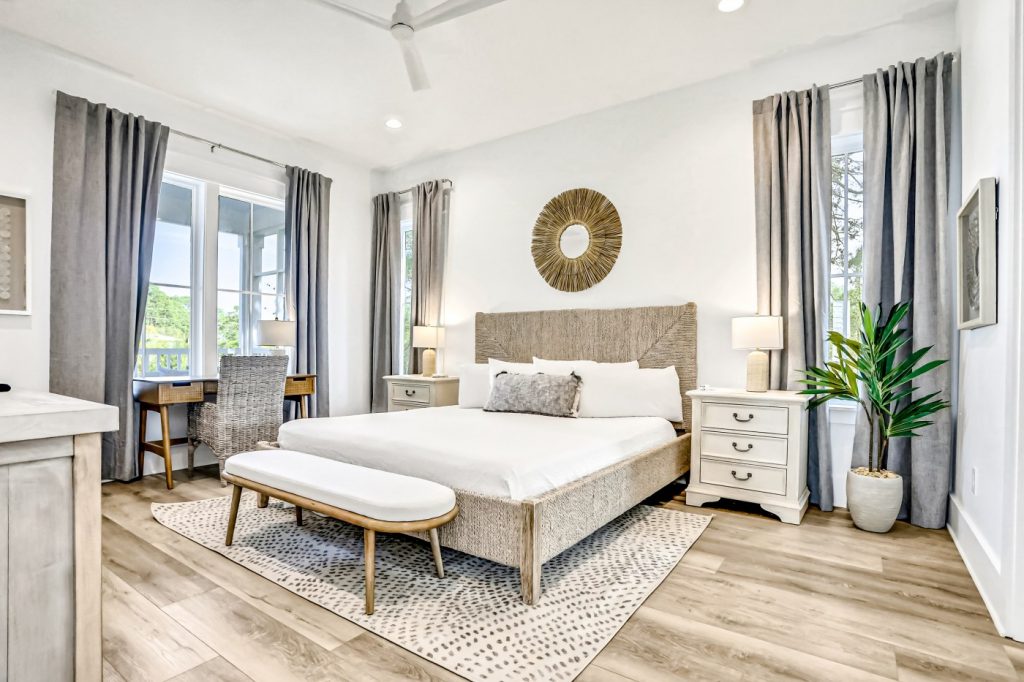The place came fully furnished. That’s the good news and the bad news. Although I yearn to redecorate, a little voice inside me tells me I need to follow my own advice. Interior design Rule No. 1 is don’t buy anything until you have the whole plan in mind
Oh bother.
I am jonesing to replace the dark brown, fake leather sofa set with a lighter-colored sectional, to update the kitchen, to change the wall color and to revisit the artwork. But I am sitting tight, until I have my decorating ducks in a row.
So I call interior designer Alex McBride, program design manager for Vacasa, which handles vacation home rentals for 40,000 places throughout North America — including interior design consultation for Vacasa clients.
“My job is to help new owners optimize their property by thinking of everything from headboards to pizza cutters,” McBride tells me. Her goal is to design places that have wide appeal, high durability and repeat customers. It’s one thing to design and decorate your own home, but the rules change when you’re outfitting a place you’ll be sharing with strangers.
“In your own home, you can unleash as much of your individuality as you like,” she says. “But decorating a rental home is different. For starters, no family photos.” Got it.
What other differences should DIY decorators keep in mind when furnishing a vacation rental home?
Resist the urge to jump right in. Get to know the place, then let the locale — a beach condo, a cozy cabin, an urban loft — lead you. If you’re on the coast, for instance, pull in shades of blue and natural tones of sand and driftwood. If you’re in the mountains, incorporate cool greens and earth tones.
Don’t get too kitschy. Avoid overtly themed décor, like pillows that say: “Life’s a Beach” or a throw blanket with images of bears. “Our design team’s first decorating rule is don’t be too literal,” McBride says. “Rather than displaying beachy paraphernalia, evoke the seaside by bringing in coastal colors and textures, such as rope and rattan.” Bring in actual pinecones or shells or vintage life preservers, rather than images of them.
Curb the color. Aim for a neutral palette in a rental. That will appeal to the largest number of customers. You don’t need to stick with white, beige and gray. Adding touches of darker sage or smoke will help hide dirt but avoid primary colors.
Choose durable materials and upholstery. Sandy feet, snowy boots and sunscreen can wreak havoc on carpet and furniture. So opt for hard floors, not carpet. Cover upholstered pieces in durable fabrics like Crypton, canvas, Sunbrella and leather, which can withstand wear. When available, choose commercial (as opposed to residential) grade products. For tables and case goods, look for solid hard wood or metal. “It’s hard to resist that nightstand made of MDF or particle board that’s only $50,” McBride says, “but it’s not going to hold up.”
Bring on the amenities. The little touches are often what brings guests back. Aside from the basics — dishes, cutlery, cookware, serving dishes, soap, towels, a blow dryer — think of what would help guests better enjoy their stay: marshmallow roasting sticks, gourmet coffee, beach towels, board games, a small library of (non-controversial) books, lightweight folding chairs, thoughtful toiletries.
A place to work. With so many people working remotely, guests welcome a small workspace — a work surface, Wi-Fi and ample outlets for devices are all you need.
Related Articles
What to consider before taking the second-home plunge
Memories, friends, timing drive wish for a second home
7 holiday decorating tips: Get a better look in less time
10 do-ahead tips to get organized before — not after — the holidays
Where to save. Although you may need to spend a bit more on durable furniture items, you can spend less on rugs and art. Rugs will likely need frequent replacement, and to guard against “attrition,” you don’t want gallery level art or anything of high value.
Go easy on accessories. You might like photos and mementos at home, but keep your vacation rental space spare. Guests want surface area to set their reading material, phones and drinks on, especially in bedrooms.
Time it right. Although you may need to go off the rental market while you remodel, you also don’t want to turn down a rental, because you’re waiting for a sofa to arrive. “Maximizing both looks and revenue may mean compromising on a choice,” McBride said. “Don’t let perfect be the enemy of good.”
Marni Jameson is the author of seven books, including the forthcoming “Rightsize Today to Create Your Best Life Tomorrow,” due out Jan. 2. Reach her at www.marnijameson.com.


